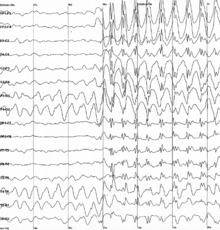
Back نوبة (طب) Arabic Epileptički napad BS Atac epilèptic Catalan Krampfanfall German Επιληπτική κρίση Greek Convulsión epiléptica Spanish حمله صرع Persian Crise d'épilepsie French פרכוס אפילפטי HE दौरा Hindi
| Epileptic seizure | |
|---|---|
| Other names | Epileptic fit,[1] seizure, fit, convulsions[2] |
 | |
| Generalized 3 Hz spike and wave discharges in an electroencephalogram (EEG) of a patient with epilepsy | |
| Specialty | Neurology, emergency medicine |
| Symptoms | Variable[3] |
| Complications | Falling, drowning, car accidents, pregnancy complications, emotional health issues[4] |
| Duration | Typically < 2 minutes[5] |
| Types | Focal, generalized; Provoked, unprovoked[6] |
| Causes | Provoked: Low blood sugar, alcohol withdrawal, low blood sodium, fever, brain infection, traumatic brain injury[3][6] Unprovoked: Unknown, brain injury, brain tumor, previous stroke[5][3][6][7] |
| Diagnostic method | Based on symptoms, blood tests, medical imaging, electroencephalography[7] |
| Differential diagnosis | Syncope, psychogenic non-epileptic seizure, migraine aura, transient ischemic attack[3][5] |
| Treatment | Less than 5 min: Place person on their side, remove nearby dangerous objects[8] More than 5 min: Treat as per status epilepticus[8] |
| Frequency | ~10% of people (overall worldwide lifetime risk)[5][9] |
A seizure is a period of symptoms due to abnormally excessive or synchronous neuronal activity in the brain.[6] Outward effects vary from uncontrolled shaking movements involving much of the body with loss of consciousness (tonic-clonic seizure), to shaking movements involving only part of the body with variable levels of consciousness (focal seizure), to a subtle momentary loss of awareness (absence seizure).[3] These episodes usually last less than two minutes and it takes some time to return to normal.[5][8] Loss of bladder control may occur.[3]
Seizures may be provoked and unprovoked.[6] Provoked seizures are due to a temporary event such as low blood sugar, alcohol withdrawal, abusing alcohol together with prescription medication, low blood sodium, fever, brain infection, flashing images or concussion.[3][6] Unprovoked seizures occur without a known or fixable cause such that ongoing seizures are likely.[5][3][6][7] Unprovoked seizures may be exacerbated by stress or sleep deprivation.[3] Epilepsy describes a brain disease in which there has been at least one unprovoked seizure and where there is a high risk of additional seizures in the future.[6] Conditions that look like epileptic seizures but are not include: fainting, nonepileptic psychogenic seizure and tremor.[3]
A seizure that lasts for more than a brief period is a medical emergency.[10] Any seizure lasting longer than five minutes should be treated as status epilepticus.[8] A first seizure generally does not require long-term treatment with anti-seizure medications unless a specific problem is found on electroencephalogram (EEG) or brain imaging.[7] Typically it is safe to complete the work-up following a single seizure as an outpatient.[3] In many, with what appears to be a first seizure, other minor seizures have previously occurred.[11]
Up to 10% of people have had at least one epileptic seizure in their lifetime.[5][9] Provoked seizures occur in about 3.5 per 10,000 people a year while unprovoked seizures occur in about 4.2 per 10,000 people a year.[5] After one seizure, the chance of experiencing a second one is about 40%.[12][13] Epilepsy affects about 1% of the population at any given time.[9]
- ^ Shorvon S (2009). Epilepsy. OUP Oxford. p. 1. ISBN 9780199560042.
- ^ "Epileptic Seizures - National Library of Medicine". PubMed Health. Retrieved 16 October 2018.
- ^ a b c d e f g h i j k Misulis KE, Murray EL (2017). Essentials of Hospital Neurology. Oxford University Press. p. Chapter 19. ISBN 9780190259433.
- ^ Mayo Clinic Staff. "Seizures – Symptoms and causes". Mayo Clinic.
- ^ a b c d e f g h Ferri FF (2018). Ferri's Clinical Advisor 2019 E-Book: 5 Books in 1. Elsevier Health Sciences. p. 959. ISBN 9780323550765.
- ^ a b c d e f g h Fisher RS, Acevedo C, Arzimanoglou A, Bogacz A, Cross JH, Elger CE, et al. (April 2014). "ILAE official report: a practical clinical definition of epilepsy". Epilepsia. 55 (4): 475–482. doi:10.1111/epi.12550. PMID 24730690. S2CID 35958237.
- ^ a b c d Wilden JA, Cohen-Gadol AA (August 2012). "Evaluation of first nonfebrile seizures". American Family Physician. 86 (4): 334–340. PMID 22963022.
- ^ a b c d "The Epilepsies and Seizures: Hope Through Research". National Institute of Neurological Disorders and Stroke. Retrieved 16 October 2018.
- ^ a b c "Epilepsy". World Health Organization. 9 February 2023. Retrieved 4 June 2023.
- ^ Schachter SC, Shafer PL, Sirven JI (5 November 2013). "What Is A Seizure Emergency". epilepsy.com.
- ^ Angus-Leppan H (April 2014). "First seizures in adults". BMJ. 348: g2470. doi:10.1136/bmj.g2470. PMID 24736280. S2CID 31709502.
- ^ Cite error: The named reference
:0was invoked but never defined (see the help page). - ^ Cite error: The named reference
:9was invoked but never defined (see the help page).
© MMXXIII Rich X Search. We shall prevail. All rights reserved. Rich X Search